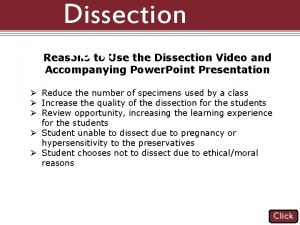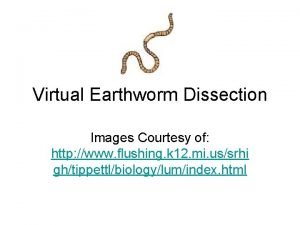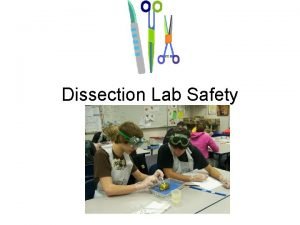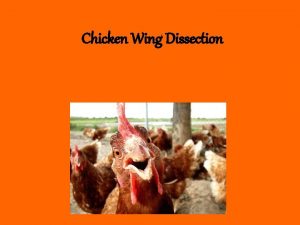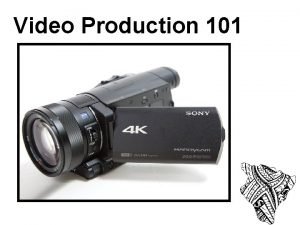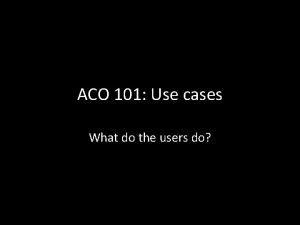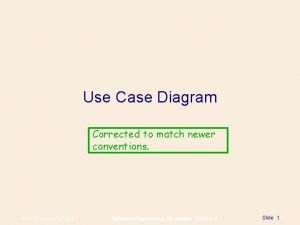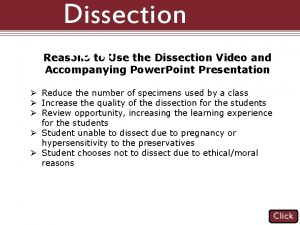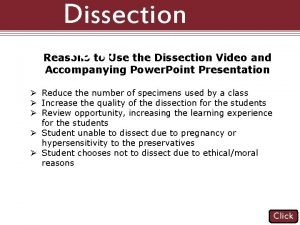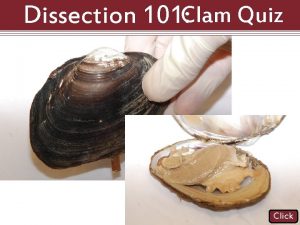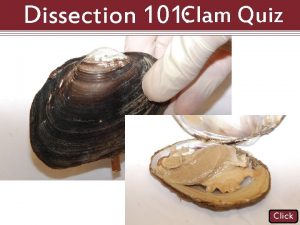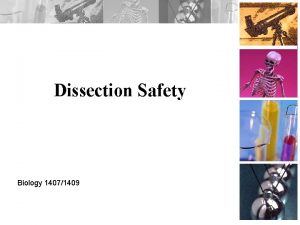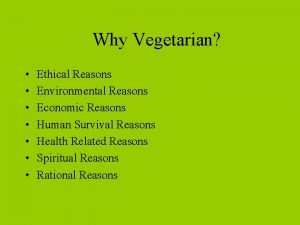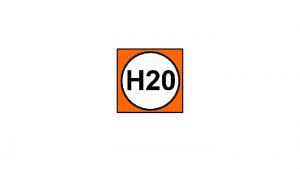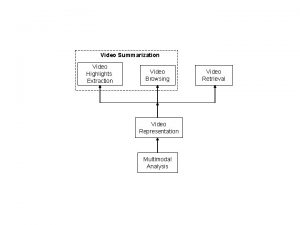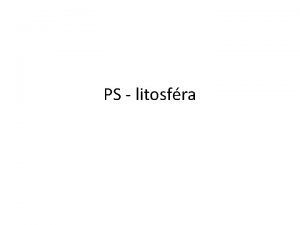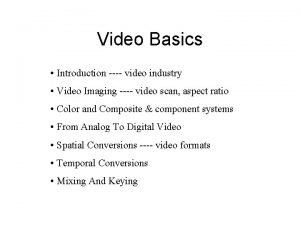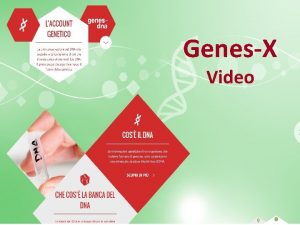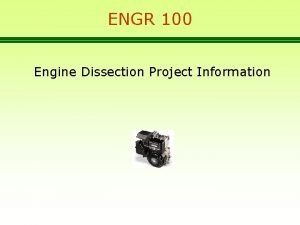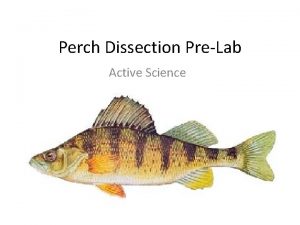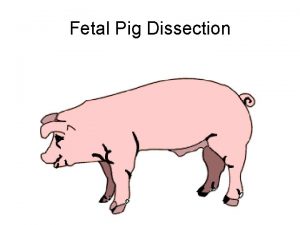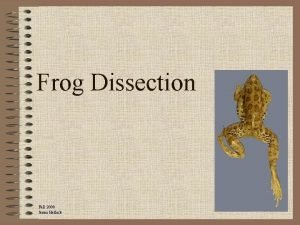Dissection 101 Reasons to Use the Dissection Video


























- Slides: 26

Dissection 101: Reasons to Use the Dissection Video and Accompanying Power. Point Presentation Ø Reduce the number of specimens used by a class Ø Increase the quality of the dissection for the students Ø Review opportunity, increasing the learning experience for the students Ø Student unable to dissect due to pregnancy or hypersensitivity to the preservatives Ø Student chooses not to dissect due to ethical/moral reasons Click

Dissection 101: As an Considerations educator you are responsible for the implementation Safety of the dissection activity described in the video and Ø Age appropriate activity for the children in your care Power. Point. You must have safety procedures and rules Ø Material Safety Data Sheet (MSDS) available for accident established for your classroom and make sure all of the reference students rules to ensure safe environment. Ø Poison follow control the number/phone readily a available Public and Dakota ØSouth Latex Dakota free gloves, eye Broadcasting protection and apron/lab coat State University any way be responsible or liable for Ø Eyewashcannot station, in shower and sink Ø any Sharp instruments (cut away from self and others) injury as a result of performing the described Ø dissection. Sharps and specimen(s) disposal Complete the dissection if you feel it is Ø Encourage students to report all accidents appropriate and safe for your individual class. Ø Basic science laboratory rules (strictly enforced) Have fun and stay safe! Click

Dissection 101: Sheep Heart Click

Dissection 101: Sheep Heart Getting Started Ø Use water to rinse the excess preservative from your heart Click

Dissection 101: Sheep Heart The sheep heart is an excellent specimen to use for comparative human anatomy in both size and function. The sheep heart is mammalian, having four chambers like the human heart, which includes two atria and two ventricles. The blood flow through the sheep heart is like that of the human heart, in which the blood is pumped from the right side of the heart to the lungs and then from the left side of the heart to the body. Click

Dissection 101: Orientation: 1 st Sheep Example Heart Anterior view (front) Posterior view (back) It is easiest to distinguish the posterior and Things to anterior of the heart by observing look for: Right the ventricles. Each heart will Right Ventricle Left look a little different, but there are specific Ventricle things to look for. The following slides show three different hearts. Apex(Also, anatomic left and right are from the viewpoint of the Anterior view points right; specimen. For example, the left ventricle is posterior view an anatomical term describing the ventricle points left on the left side, but it will appear, many interventricular Anterior times, interventricular on the side. Posterior when viewed in The leftright ventricle has more sulcus runs books, on yourwhen tray, pressed, and in this Power. Point. ) resistance because the more vertical diagonal towall the (muscle) left is much thicker. Click

Dissection 101: Orientation: 2 nd Anterior view (front) Right Ventricle Sheep Example (different heart) Heart Posterior view (back) Things to look for: Left Ventricles Right Ventricle Apex Anterior view points right; posterior view points left Posterior interventricular Anterior interventricular The left ventricle has more sulcus runs resistance when pressed, because the more vertical diagonal to the wallleft (muscle) is much thicker. Click

Dissection 101: Orientation: 3 rd Sheep Example (different view) Heart The connective tissue and fat have been removed from the heart on the left. Right Ventricle Left Ventricles Anterior view (front) Right Ventricle Posterior view (back) Click

Dissection 101: Left atrium Sheep Heart Structures Right ventricle atrium (atria: – Muscular plural) – structure Muscular of structure the heart of that the heart pumps that pumps oxygen poor blood to the lungs right ventricle Left atrium (atria: plural) – ventricle – Muscular structure of that the heart structure of the heart that pumps oxygen rich blood to to left ventricle thethe body Auricle – Outerpointed ear like region Apex – Inferior of the heart left and right atria (left ventricle) Anterior view (front) tilted down Click

Dissection 101: Sheep Heart There are many vessels entering and leaving the heart. In general, larger vessels leaving the heart are called arteries and larger vessels carrying blood to the heart are called veins. It can be very difficult to identify the vessels, especially if some have been removed by the supplier. On the following slide we will identify vessels which can be easily identified. Many of the other vessels will be identified later with the use of probes that will follow the flow of blood from the heart. Click

Dissection 101: Sheep Easily Identified Vessels Heart Brachiocephalic artery – Forms right subclavian artery and common carotid artery; oxygen rich Aorta – Oxygen rich blood from left ventricle to the body R. A. L. A. R. V. Close-up ligamentum L. V. arteriosum Ligamentum arteriosum – Remnant of ductus arteriosus during fetal development Pulmonary Trunk (artery) – Oxygen poor blood from right ventricle to lungs via right and left pulmonary arteries Click

Dissection 101: Sheep Heart Getting Started – Initial Cuts (You. Tube Version) Click

Dissection 101: Sheep Heart Dissection Use probes to identify the superior and inferior vena cava, which supply oxygen poor blood to the right atrium from the body. Right atrium Click

Dissection 101: Sheep Heart Dissection Use the superior vena cava probe, as a guide, to cut down through the wall of the right atrium and right ventricle Right atrium Right ventricle Click

Dissection 101: Right atrioventricular (AV) valve (also called tricuspid valve) – Prevents backflow of blood into right atrium when right ventricle pumps blood to lungs Sheep Heart Right atrium Right ventricle Clic k

Dissection 101: Tricuspid valve (right AV valve) Chordae tendineae Chord like structures (tendon) that connect the tricuspid valve to the papillary muscle Papillary muscle – Contracts preventing tricuspid valve from entering the atrium when ventricle pumps blood Sheep Heart Right atrium Right ventricle Clic k

Dissection 101: Sheep Heart Right ventricle Use a probe to locate the pulmonary trunk Clic k

Dissection 101: Sheep Heart Once the pulmonary trunk is located, cut the right ventricle along the probe to expose the semilunar valves and pulmonary trunk Clic k

Dissection 101: Sheep Heart Pulmonary trunk Pulmonary semilunar valve – Prevents backflow of blood from pulmonary trunk into right ventricle Close-up view Cut right ventricle (probe removed) Clic k

Dissection 101: Sheep Heart Left atrium Use a probe to locate the insertion of the pulmonary veins, which bring oxygen rich blood from the lungs to the left atrium; then cut the left atrium along the probe Clic k

Dissection 101: Sheep Heart Left atrium L. V. Probe is passing through the mitral valve into the left ventricle Cut along the probe to expose the interior of the left ventricle Clic k

Dissection 101: Wall left ventricle Left atrium Sheep Heart Left atrioventricular (AV) valve (also called bicuspid valve or mitral valve) – Prevents backflow of blood into left atrium when left ventricle pumps blood to body Chordae tendineae Papillary muscles Close-up view mitral valve Clic k

Dissection 101: Sheep Heart Exposing the Aortic Semilunar Valve (You. Tube Version) Clic k

Dissection 101: Aorta Sheep Heart L. V. Use a probe to locate the aorta; then cut the left ventricle along the probe exposing the aortic semilunar valve Clic k

Dissection 101: Sheep Heart Aorta Aortic semilunar valve – prevents backflow of blood from aorta into left ventricle Mitral valve Clic k

Dissection 101: Sheep Heart Produced by Dakota State University and South Dakota Public Broadcasting Science Steve Sponsors
 Dissection 101 sheep heart quiz
Dissection 101 sheep heart quiz Claimclik
Claimclik Dissection 101 sheep heart quiz
Dissection 101 sheep heart quiz Earthworm images
Earthworm images Ekimme
Ekimme Anatomy of starfish
Anatomy of starfish Chicken wing dissection lab
Chicken wing dissection lab The supportive stance
The supportive stance 3 reasons to use supportive stance
3 reasons to use supportive stance Video production 101
Video production 101 Video 101
Video 101 Videos yandex search
Videos yandex search Video.search.yahoo.com search video
Video.search.yahoo.com search video Videos yahoo search
Videos yahoo search The frame size of a video refers to the video’s
The frame size of a video refers to the video’s Use case 101
Use case 101 Sequence diagram for video rental system
Sequence diagram for video rental system How to use viva video step by step
How to use viva video step by step Hát kết hợp bộ gõ cơ thể
Hát kết hợp bộ gõ cơ thể Slidetodoc
Slidetodoc Bổ thể
Bổ thể Tỉ lệ cơ thể trẻ em
Tỉ lệ cơ thể trẻ em Chó sói
Chó sói Chụp tư thế worms-breton
Chụp tư thế worms-breton Chúa sống lại
Chúa sống lại Môn thể thao bắt đầu bằng chữ f
Môn thể thao bắt đầu bằng chữ f Thế nào là hệ số cao nhất
Thế nào là hệ số cao nhất
